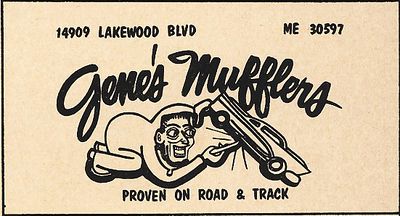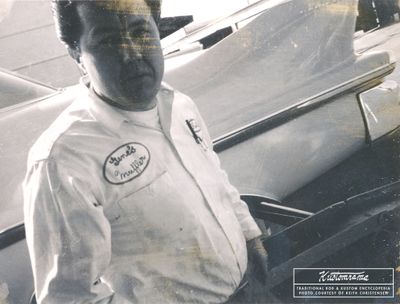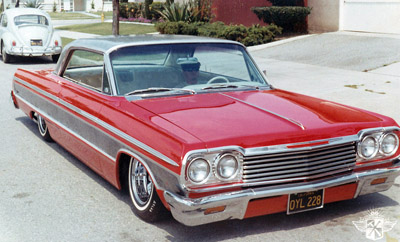Gene's Mufflers




Gene's Mufflers was run and operated by Gene Moore. The shop was located at 14909 Lakewood Blvd.
Contents
"If you ever want to sell, let me know!"
In 1958 Keith Christensen of Norwalk, California told Moore that he was interested in buying his booming business. In 2016 Christensen told Sondre Kvipt of Kustomrama that he just had gotten married. He was in college and worked at a Supermarket; "I took my bosses 1956 Ford truck and my 1955 Ford truck to a tiny shop where my younger brother started working. Aman in the Jr Chamber, who sponsored the Coachmen car club, had a muffler shop in Norwalk. A short distance by the way from where Sam Barris lived. He gave my younger brother a job sweeping and cleaning his muffler shop, called Sport Muffler. My brother learned the muffler trade and in my getting acquainted with Gene, I got him a job there. It was called Gene's Muffler. Located on the border of Paramount and Bellflower, the shop was an old real estate office and a two-car garage that Gene had put a pit with a couple of racks in between. Coming into that little shop, I noticed Gene was doing great and I told him if he ever wanted to sell the shop let me know. He was driving a fairly new 1956 Ford pickup, had a wild ski boat and a new car for his wife. Not bad for a young man!"[1]
Keith Christensen Buys the Shop and Expands it
Later on, Gene got in trouble with the sales tax department and needed money. "I hocked everything and paid $3,500.00 for the shop," Christensen told Kustomrama. "The name had a good reputation so I just kept it. Later I bought the land next door and built a very large muffler shop that could do 6 cars at a time. In the front building, I put a tire and wheel company and a small manufacturing building in between. It did great so I put shops in Downey and Hollydale, two cities nearby. We did all of the lowering and lifting of cars and installed dual exhaust on thousands of cars over that period. In his youth, without a beard or styled hair, Larry Watson moved into a building directly across the shop area from my original muffler, customizing shop. There he took on his aura of beard and styled hair," Christensen recalled.[1]
Chevy Split Six Dual Exhaust Systems
When Keith bought the shop, 6 cylinder cars were abundant and the Chevrolet 6 was the most popular for the custom car enthusiasts to modify. "Splitting the exhaust manifold into two outlets made the most beautiful sounds," Keith recalled in 2022. "Two exhaust ports out each outlet, as all the ports mixing the exhausts together gave a mixed sound wave and a poor one. Fewer ports out each one made a much purer sound. Hooked on to a pair of glasspack mufflers was a sound to hear and enjoy."[1]
At the shop, Keith would unbolt the exhaust manifold and separate it from the intake manifold as they were connected together. "With it apart, we would weld a plate up inside the manifold which blocked the exhaust from one half going out the port with the other half. We then cut a hole in the blocked half and made a new port for that side to exit. Three cylinders on each side of the block. The better the block in between, the less the two sides could mix their sounds. The purer the better. A great way to customize a 6 cylinder car and give it the sound everyone envied...." Keith and his crew did a tremendous amount of cars this way as the customizing craze was in full swing.[1]
Lesson Learned
One day, not long after Keith had purchased the shop, a fellow brought his 1954 Chevrolet in to put dual exhaust on it. "It was afternoon and it involved about a 3-hour job, so we started right on it. Before we put a car on the rack, we would remove the intake and exhaust manifolds. We had a lot of customers' cars still to finish and it was getting late in the day. A lot of interruptions, so finally at almost quitting time we split the exhaust manifold, welded the block up inside separating the two sides, and put the other outlet flange on the manifold. Now manifold blocked with two outlets on it we bolted the two manifolds (intake and exhaust) back together. And installed them back onto the side of the engine, hooked up the gas line, and put the carburetor back on...This made it ready to pull up on the rack. Of course, the exhaust pipe wasn't back on the original outlet, so it made it loud to fire up, but easier to hook back up after it was on the rack and we could get underneath the car. One of us ground on the starter and we stood next to the car waiting for the roar of the motor. One problem. No roar? It ground, it sputted, it vibrated, but didn't start? We thought maybe no gas? We loosened the gas line, crank it and there was gas pouring out. The customer mentioned that he had been having a hard time starting the car and it had a miss when it first started, so we pulled the plug wires and of course, now it was dark outside, so guaranteed the one pulling the coil wire got shocked a few times. There was a spark, as we would see him jump and yell, and not the best of words. Still, it wouldn't start. He said sometimes the float in the carburetor stuck so sometimes no gas would get into the manifold. We thought that might be the problem, but as it was dark and late and the customer pushed us telling us he had to get home and needed the car for work the next day, we were getting desperate. Well, we wanted to try anything. The muffler shop sat at the front of the small auto complex, with other shops behind with a common driveway down the middle. In the rear at that time, there was a mechanic with a group of cars in a fenced bullpen, waiting to be worked on. Ahah! An idea popped up; there was a 54 Chevrolet sitting at the back of the bullpen that had been there for quite a while. The mechanic was an amiable sort, so we didn't think he would mind if we borrowed the carb off of the parked car. We would put it back after we used it to see if our customer's carb was bad. In the dark, it was late, we climbed the fence not looking for a gate or any other way to get at that Chevvy. We borrowed the carburetor and went back over the fence."[1]
Back at the shop, they proceeded to install the borrowed carburetor. "We hooked everything back up and once again started cranking. Still nothing! But "WOW", the single and only benefit of working in the dark with a flashlight is that we saw sparks and smoke coming out from behind the exhaust manifold, but only on one end of the manifold? Well, the "lightbulb" came on! We had put the block on one side of the exhaust manifold!!!! So three cylinders had two outlets, and the other three were totally blocked off with no outlet. No wonder it popped and snorted. The exhaust was totally blocked on one side. Lesson well learned! Don't work on a bench in the dark and be in a giant hurry. We had to take both manifolds off, separate them, cut the block out inside of the exhaust manifold and install a fresh one on the opposite and proper side. Yeah! We now had 3 cylinders going out each side of the split manifold. We bolted his old carburetor back on, fired it up, pulled the chevvy up on the rack, and did the fastest dual job in history. The customer got to go home and was super happy and got a good discount. We cleaned up all of our mess, closed the doors, and decided it would wait until morning to go back out in that dark old yard to put back the borrowed carburetor, besides, we were greasy and tired and it was 11 o'clock at night. At least the night ended happily, or so we thought. It was related to us the next morning by one of the mechanics helpers, "that when they came to work, one of the first things the shop owner did was to open the bullpen gate, move cars out of the way and start to take that 54 chevvy into the shop and work on it. Oh no! No carburetor! On a 6 cylinder chevy, without the carburetor on it, the fuel line is sitting above the inlet on the intake manifold and pointing directly down into it. With him sitting in the driver's seat, with a coffee in hand, he cranked the motor over and about the third crank, the motor fired, and boy did it fire! From zero RPMs to eternal RPMs and beyond 6000 RPMs...the rest is history!! The motor exploded. The poor mechanic owner, sitting half asleep, coffee cup in hand, spilled the coffee all over him and the interior of the car. "Stone silence" after that explosion, he gingerly stepped out of the car and into a giant puddle of oil flowing out from under the car...Needless to say, He wasn't a happy mechanic."[1]
After the helper told Keith about the explosion, it became a tough decision for him, but he had to be honest and face the music. "I went to the rear where his office was and gingerly said hello. He said, "Keith, what in the hell did you do?" After I explained the previous night's episode, he got a sort of grin on his face and said "Keith there's one good thing about this. I've been nursing along with the owner's tired old 54 for a long time and it was on a last leg, so now he gets a new motor out of this. I will build it, and you will pay for it! And further Keith, you owe me a new shirt, just look at mine..." According to Keith, this was a small episode when he started out in the automotive field. "Looking back, it has been a great industry to be a part of. I wouldn't trade the wonderful life it has given me," Keith told Kustomrama.[1]
Bellflower Chrome Tips
Keith started building driveshaft tips and bed rail pipes. He developed a manufacturing division, and after seeing how lifted cars were dragging up driveways, he got the idea to put a 90-degree elbow pipe on the front of his driveshaft tips; "I chromed the whole thing, that let us put them on the outside of the fenders, just behind the tires. Since I was next to the town of Bellflower, where I lived, I called them Bellflower Chrome Tips! The name stuck with them to this day," Keith told Sondre.[1]
Tom Kelly logo
In 1963 Tom Kelly designed a logo for Keith. "Tom specialized in large murals and pinstriping on motorhomes and big trucks." He designed a logo containing two glass packs crossing inside an Iron cross, and Keith had it made into decals, jackets, and shirts. He also painted it on the doors of some of his shop trucks.[1]
Car Show Promotion
Keith used to sponsor cars for friends and customers that were displayed in car shows. "I would loan them beautiful wheels and make signs for them of course including a little blip of Gene's Mufflers on the signs."[1]
References
Did you enjoy this article?
Kustomrama is an encyclopedia dedicated to preserve, share and protect traditional hot rod and custom car history from all over the world.
- Help us keep history alive. For as little as 2.99 USD a month you can become a monthly supporter. Click here to learn more.
- Subscribe to our free newsletter and receive regular updates and stories from Kustomrama.
- Do you know someone who would enjoy this article? Click here to forward it.
Can you help us make this article better?
Please get in touch with us at mail@kustomrama.com if you have additional information or photos to share about Gene's Mufflers.
This article was made possible by:
SunTec Auto Glass - Auto Glass Services on Vintage and Classic Cars
Finding a replacement windshield, back or side glass can be a difficult task when restoring your vintage or custom classic car. It doesn't have to be though now with auto glass specialist companies like www.suntecautoglass.com. They can source OEM or OEM-equivalent glass for older makes/models; which will ensure a proper fit every time. Check them out for more details!
Do you want to see your company here? Click here for more info about how you can advertise your business on Kustomrama.






